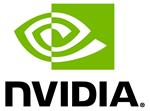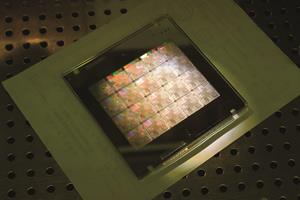SANTA CLARA, Calif., March 21, 2023 (GLOBE NEWSWIRE) --
GTC -- NVIDIA today announced a breakthrough that brings accelerated computing to the field of computational lithography, enabling semiconductor leaders like ASML, TSMC and Synopsys to accelerate the design and manufacturing of next-generation chips, just as current production processes are nearing the limits of what physics makes possible.
The new NVIDIA cuLitho software library for computational lithography is being integrated by TSMC, the world’s leading foundry, as well as electronic design automation leader Synopsys into their software, manufacturing processes and systems for the latest-generation NVIDIA Hopper™ architecture GPUs. Equipment maker ASML is working closely with NVIDIA on GPUs and cuLitho, and is planning to integrate support for GPUs into all of its computational lithography software products.
The advance will enable chips with tinier transistors and wires than is now achievable, while accelerating time to market and boosting energy efficiency of the massive data centers that run 24/7 to drive the manufacturing process.
“The chip industry is the foundation of nearly every other industry in the world,” said Jensen Huang, founder and CEO of NVIDIA. “With lithography at the limits of physics, NVIDIA’s introduction of cuLitho and collaboration with our partners TSMC, ASML and Synopsys allows fabs to increase throughput, reduce their carbon footprint and set the foundation for 2nm and beyond.”
Running on GPUs, cuLitho delivers a performance leap of up to 40x beyond current lithography — the process of creating patterns on a silicon wafer — accelerating the massive computational workloads that currently consume tens of billions of CPU hours every year.
It enables 500 NVIDIA DGX H100 systems to achieve the work of 40,000 CPU systems, running all parts of the computational lithography process in parallel, helping reduce power needs and potential environmental impact.
In the near term, fabs using cuLitho could help produce each day 3-5x more photomasks — the templates for a chip’s design — using 9x less power than current configurations. A photomask that required two weeks can now be processed overnight.
Longer term, cuLitho will enable better design rules, higher density, higher yields and AI-powered lithography.
Support From Industry Leaders
NVIDIA is working with key partners to smooth the speedy adoption of these new technologies.
“The cuLitho team has made admirable progress on speeding up computational lithography by moving expensive operations to GPU,” said Dr. C.C. Wei, CEO of TSMC. “This development opens up new possibilities for TSMC to deploy lithography solutions like inverse lithography technology and deep learning more broadly in chip manufacturing, making important contributions to the continuation of semiconductor scaling.”
“We are planning to integrate support for GPUs into all of our computational lithography software products,” said Peter Wennink, CEO of ASML. “Our collaboration with NVIDIA on GPUs and cuLitho should result in tremendous benefit to computational lithography, and therefore to semiconductor scaling. This will be especially true in the era of high NA extreme ultraviolet lithography.”
“Computational lithography, specifically optical proximity correction, or OPC, is pushing the boundaries of compute workloads for the most advanced chips,” said Aart de Geus, chair and CEO of Synopsys. “By collaborating with our partner NVIDIA to run Synopsys OPC software on the cuLitho platform, we massively accelerated the performance from weeks to days! The team-up of our two leading companies continues to force amazing advances in the industry.”
Enabling Semiconductor Scaling
The cost of the computational time needed for the largest workloads in semi manufacturing has in recent years been outpacing Moore’s law, due to both the larger number of transistors in newer nodes and more stringent accuracy requirements. Future nodes require more detailed calculations, not all of which can feasibly fit into the available computational bandwidth provided by the current platforms, slowing the pace of innovation in semiconductors.
A fab process change often requires an OPC revision, creating bottlenecks. cuLitho helps remove these bottlenecks, and it makes possible novel solutions and innovative techniques like curvilinear masks, high NA EUV lithography, and sub-atomic photoresist modeling needed for new technology nodes.
To learn more, watch Huang’s GTC 2023 keynote and attend the conference session “ Accelerating Computational Lithography” presented by NVIDIA cuLitho architect Vivek K. Singh. Registration for GTC is free.
About NVIDIA
Since its founding in 1993, NVIDIA (NASDAQ: NVDA) has been a pioneer in accelerated computing. The company’s invention of the GPU in 1999 sparked the growth of the PC gaming market, redefined computer graphics, ignited the era of modern AI and is fueling the creation of the metaverse. NVIDIA is now a full-stack computing company with data-center-scale offerings that are reshaping industry. More information at
https://nvidianews.nvidia.com/.
For further information, contact:
Liz Archibald
Corporate Communications
NVIDIA Corporation
Email Contact
Certain statements in this press release including, but not limited to, statements as to: the benefits, impact, availability and performance of our products and technologies, including cuLitho software library, NVIDIA Hopper architecture GPUs and NVIDIA DGX H100 systems; the benefits, impact, performance, availability and progress of integration of cuLitho software library by and collaboration with third-parties, including ASML, TSMC and Synopsys; NVIDIA working with key partners to smooth the speedy adoption of cuLitho software library are forward-looking statements that are subject to risks and uncertainties that could cause results to be materially different than expectations. Important factors that could cause actual results to differ materially include: global economic conditions; our reliance on third parties to manufacture, assemble, package and test our products; the impact of technological development and competition; development of new products and technologies or enhancements to our existing product and technologies; market acceptance of our products or our partners’ products; design, manufacturing or software defects; changes in consumer preferences or demands; changes in industry standards and interfaces; unexpected loss of performance of our products or technologies when integrated into systems; as well as other factors detailed from time to time in the most recent reports NVIDIA files with the Securities and Exchange Commission, or SEC, including, but not limited to, its annual report on Form 10-K and quarterly reports on Form 10-Q. Copies of reports filed with the SEC are posted on the company’s website and are available from NVIDIA without charge. These forward-looking statements are not guarantees of future performance and speak only as of the date hereof, and, except as required by law, NVIDIA disclaims any obligation to update these forward-looking statements to reflect future events or circumstances.
© 2023 NVIDIA Corporation. All rights reserved. NVIDIA, the NVIDIA logo, and NVIDIA Hopper are trademarks and/or registered trademarks of NVIDIA Corporation in the U.S. and other countries. Other company and product names may be trademarks of the respective companies with which they are associated. Features, pricing, availability, and specifications are subject to change without notice.
A photo accompanying this announcement is available at https://www.globenewswire.com/NewsRoom/AttachmentNg/1a1c3153-f17d-44ba-8fbf-345681f27bc2











